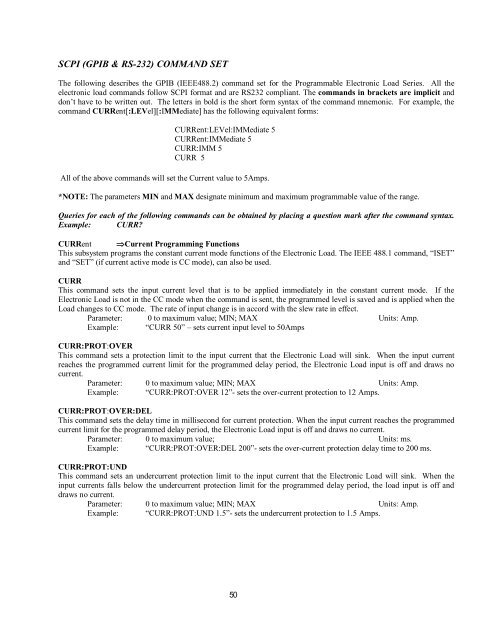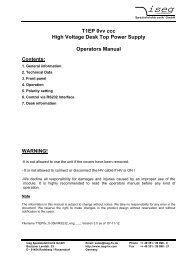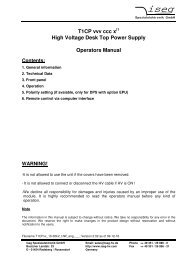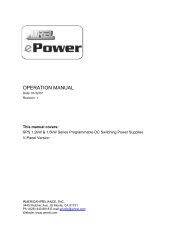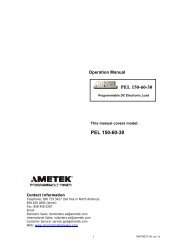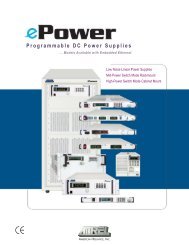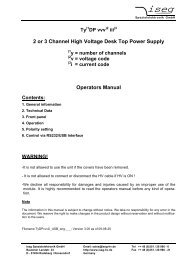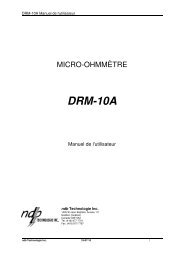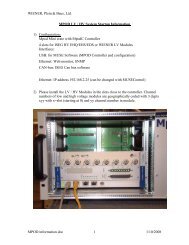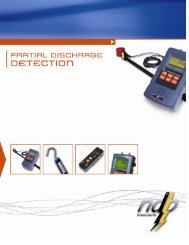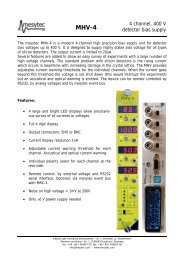PEL-60-60-10 - Physical Instruments
PEL-60-60-10 - Physical Instruments
PEL-60-60-10 - Physical Instruments
You also want an ePaper? Increase the reach of your titles
YUMPU automatically turns print PDFs into web optimized ePapers that Google loves.
SCPI (GPIB & RS-232) COMMAND SET<br />
The following describes the GPIB (IEEE488.2) command set for the Programmable Electronic Load Series. All the<br />
electronic load commands follow SCPI format and are RS232 compliant. The commands in brackets are implicit and<br />
don’t have to be written out. The letters in bold is the short form syntax of the command mnemonic. For example, the<br />
command CURRent[:LEVel][:IMMediate] has the following equivalent forms:<br />
CURRent:LEVel:IMMediate 5<br />
CURRent:IMMediate 5<br />
CURR:IMM 5<br />
CURR 5<br />
All of the above commands will set the Current value to 5Amps.<br />
*NOTE: The parameters MIN and MAX designate minimum and maximum programmable value of the range.<br />
Queries for each of the following commands can be obtained by placing a question mark after the command syntax.<br />
Example: CURR?<br />
CURRent ⇒Current Programming Functions<br />
This subsystem programs the constant current mode functions of the Electronic Load. The IEEE 488.1 command, “ISET”<br />
and “SET” (if current active mode is CC mode), can also be used.<br />
CURR<br />
This command sets the input current level that is to be applied immediately in the constant current mode. If the<br />
Electronic Load is not in the CC mode when the command is sent, the programmed level is saved and is applied when the<br />
Load changes to CC mode. The rate of input change is in accord with the slew rate in effect.<br />
Parameter: 0 to maximum value; MIN; MAX Units: Amp.<br />
Example: “CURR 50” – sets current input level to 50Amps<br />
CURR:PROT:OVER<br />
This command sets a protection limit to the input current that the Electronic Load will sink. When the input current<br />
reaches the programmed current limit for the programmed delay period, the Electronic Load input is off and draws no<br />
current.<br />
Parameter: 0 to maximum value; MIN; MAX Units: Amp.<br />
Example: “CURR:PROT:OVER 12”- sets the over-current protection to 12 Amps.<br />
CURR:PROT:OVER:DEL<br />
This command sets the delay time in millisecond for current protection. When the input current reaches the programmed<br />
current limit for the programmed delay period, the Electronic Load input is off and draws no current.<br />
Parameter: 0 to maximum value; Units: ms.<br />
Example: “CURR:PROT:OVER:DEL 200”- sets the over-current protection delay time to 200 ms.<br />
CURR:PROT:UND<br />
This command sets an undercurrent protection limit to the input current that the Electronic Load will sink. When the<br />
input currents falls below the undercurrent protection limit for the programmed delay period, the load input is off and<br />
draws no current.<br />
Parameter: 0 to maximum value; MIN; MAX Units: Amp.<br />
Example: “CURR:PROT:UND 1.5”- sets the undercurrent protection to 1.5 Amps.<br />
50


